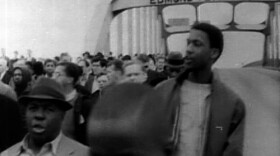If you'd like to hear more of Alabama Public Radio's international award winning coverage of the civil rights movement, click below. Pat D. All year long on Alabama Public Radio, we’re looking at the 50th anniversary of key moments in the civil rights movement. One of the biggest fights in the movement was the effort to desegregate schools. That included Tuskegee High School. In 1963, a lawsuit was filed to desegregate, and a federal court agreed. Thirteen black students were chosen to integrate the school and anticipated starting classes with their white peers on September 2nd. APR recently went to Tuskegee to talk with former students as they look back 50 years after the desegregation of the high school.
If you’ve ever been to a high school reunion, they can be a little nerve-wracking. But tonight’s gathering at the Tuskegee Human and Civil Rights Multicultural Center has a different vibe. For the former students here, all in their 60s now--it’s not so much a reunion as it is a reflection. They’re looking back on what was supposed to be the first day of classes on September 2, 1963.
Former student Willie Wyatt Jr. was one of the 13 black students integrating Tuskegee High School.
“I thought well, okay, there’s going to be three to four hundred other kids in the school,” says Wyatt. “How am I going to make friends? How am I going to be accepted? Is there anything that’s going to happen that’s going to cause me to react and respond? So that was a thought running through my head.”
But Wyatt never made it to the first day of class. No one did. That’s because Alabama Governor George Wallace intervened to stop the school from desegregating. Wyatt vividly remembers what happened that morning.
“The school was surrounded by state troopers,” says Wyatt. “And the 13 of us who boarded the bus got to the driveway of the school and the Alabama state patrol got on the bus and gave us all a copy of the executive order from the governor denying admission to this school.”
Jane Hornsby Kourkoulis also recalls that day. She would’ve started her senior year. She was supposed to be one of Wyatt’s classmates. Tonight is the first time they’ve ever met. But Kourkoulis says her concerns were different from Wyatt’s.
“In retrospect to think of the courage it took for you 13 to do that, to make history,” says Kourkoulis. “And, you know, my little petty annoyances about not being able to go to school with the same people I’d gone to school with all my life and you know, word about the prom, football games and things like that. And here were these courageous 13.”
Former student Rebecca Wadsworth Sickles is also at tonight’s event. She was supposed to start her junior year at Tuskegee High. She remembers the swarm of state troopers Wyatt talked about earlier. Sickles recalls that while she and her siblings felt intimidated, her mother did not.
“At one point, she [Sickles mother] turned around and asked all of us ‘do you students want to go to school?’ And we all said ‘yes ma’am.’ And so she walked up to the nearest trooper who was standing stone-faced and said ‘please give a message to Governor Wallace that these students want to attend school.’ And of course, he said nothing.”
Bear in mind, Sickles is white-- one of the few Caucasian students to go back to Tuskegee High when it reopened about a week later. She describes the school atmosphere as “eerie,” but her time there would be cut short.
“It was scary for me and I’m sure it was scary for those few black students that were in there,” recalls Sickles. “And one day in the middle of the school day, my daddy came to take me out. He said he was afraid of me to stay there.”
Sickles’ family sent her to live with her aunt and uncle in Alexander City. She wasn’t the only white student to be pulled out of Tuskegee High. In just a matter of days, all the white students were gone. Their families transferred them to two nearby Macon County schools-Shorter and Notasulga. The move forced Tuskegee High School to close in January 1964, and a federal court ordered some of the black students to go to Shorter, and some to attend Notsulga.
Many were caught off guard by the turn of events, but no one more so than Anthony Lee and his family.
“We had the understanding and we had prepared for a very smooth transition,” says Lee.
Lee was one of the lead plaintiffs in Lee v. Macon County Board of Education. It was the 1963 court case that forced Tuskegee High School to desegregate in the first place. So, what played out September 2nd was not what Lee or his family was expecting.
“The events that had happened that day just caught us by surprise because we thought we had prepared for everything and everything was supposed to be a very smooth transition until the closing and things like that happened.”
With the help of civil rights attorney Fred Gray, Lee v. Macon County was expanded as a blanket desegregation order. It would apply to more than 100 school districts in the state.
But that decision wouldn’t be handed down for nearly four years, long after Anthony Lee and his classmates were supposed to graduate. Lee, and fellow senior classmate Willie Wyatt Jr., were given their diplomas in ’64, but never made it to a formal graduation ceremony. They had been transferred to Notasulga and just a few days before graduation, the school was burned to the ground during this time of change.




















